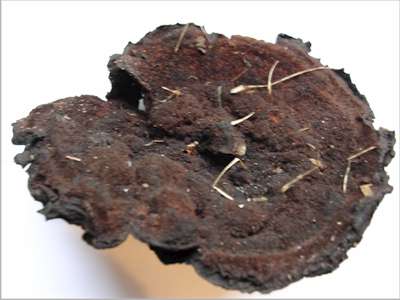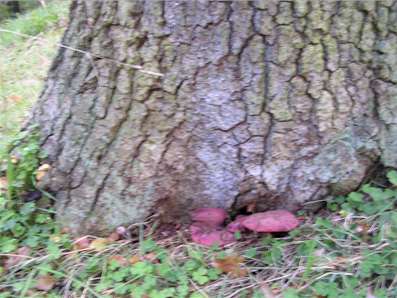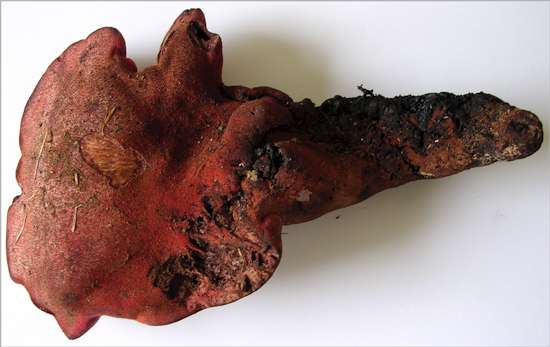..
FOCUS TOPIC: SOME MAJOR
PATHOGENS OF TREES
Several fungi
in the Basidiomycota and Ascomycota are major pathogens
of trees. These fungi can cause serious economic losses
in commercial forestry. Several of them also cause
significant damage to natural and amenity woodlands, with
huge impacts on the landscape and environment. In this
and the following pages we focus on some of these major
tree pathogens.
The diseases
we will consider include:
Heterobasidion
annosum (Basidiomycota), the fungus
that causes "Fomes root rot", or
"Annosus root rot" in conifer forests.
Armillariella
(or Armillaria)
mellea (Basidiomycota), one of the
most aggressive tree pathogens worldwide.
Sudden
oak death caused by the fungus-like
organism Phytophthora ramorum.
This organism is related to the potato blight
pathogen, Phytophthora infestans, which
is notorious for having devastated the Irish
potato crops in the period 1845 to 1847, when
perhaps more than half a million people died of
starvation and a similar number emigrated to the
rest of Europe or the USA, to escape starvation.
Dutch
elm disease, caused by a member of the
Ascomycota, Ophiostoma ulmi
(and the related fungus O. novo-ulmi).
Chestnut
blight in Europe and North America,
caused by a member of the Ascomycota, Cryphonectria
parasitica.
To put these
diseases into perspective, it will be helpful to note a
few basic points.
Many
of the diseases that sweep across continents and
cause major damage are the result of organisms
that have been introduced from other countries.
For example, this is true of chestnut
blight in North America (thought to have
been introduced on ornamental chestnut trees in
the New York Zoological Garden in 1904).
Similarly, the first report of Dutch elm
disease in the USA was in Ohio in 1930.
Since that time, it has caused major damage to
the native American elm, Ulmus americana.
Most
healthy, vigorously-growing trees show a
significant degree of resistance to fungal
attack, but their resistance can be compromised
by wounds that provide portals of entry for
pathogens. Quite often these pathogens are
host-restricted. For example, Heterobasidion
annosum (perhaps the most serious
pathogen of conifers in the Northern hemisphere)
is mainly confined to pines, including Scots pine
(Pinus sylvestris). In contrast, the
"beef-steak polypore" Fistulina
hepatica, is most commonly found on
oaks, and to a lesser extent on chestnuts (Castanea
spp.).
Several
fungi that cause serious damage to trees can
spread by root-to-root contact, when the major
roots of adjacent trees fuse with one another.
This can create an underground network for spread
of pathogens. Additionally, some tree pathogens,
such as Armillariella mellea,
can grow extensively below ground by producing
bootlace-like hyphal aggregates termed
rhizomorphs, which can initiate attack of
adjacent healthy trees.
THE
PATHOGENS:
1. Phaeolus schweinitsii

Fig
1. A young fruitbody of Phaeolus
schweinitsii, about 15 cm wide and 3 cm thick. The
young fruitbody is covered with a soft downy coating and
shows clear concentric zones. In Britain this fungus is
considered to be one of the most important pathogens of
conifers. The fruitbodies often arise from the major
roots below ground - one of the first indications that
the tree is infected. This specimen was photographed
under a larch tree (Larix europea) about 30
meters high, in an ornamental parkland. Larch is a native
of the mountains of Central Europe, but is known to have
been introduced into Britain in the 16th Century.[©
Jim Deacon]

Fig 2.
Underside of the fruitbody shown in Figure 1, showing
that the fruitbody tapers like a cone towards a thick
base. The basidiospores are released from small pores on
the underside. [© Jim Deacon]

Fig 3. As
the fruitbody of P. schweinitsii matures it
turns brown and dries, as shown in this image. [©
Jim Deacon]
2. Fistulina hepatica,
the "Beef-steak polypore"
The
fruibodies of Fistulina hepatica are usually
seen towards the base of oak or chestnut trees (Fig. 4).
The appearance of these fruitbodies in late autumn or
early winter can sometimes be the only sign of infection,
but is indicative of internal decay that leads to rotting
of the tree base - a condition termed butt rot, which can
significantly weaken the base of the tree and cause it to
break in high winds.

Fig 4.
Fruitbodies of Fistulina hepatica growing
from the base of a dead oak tree that was about 100 years
old. [© Jim Deacon]
This fungus
is a member of the Basidiomycota, and is highly
distinctive because of its red-coloured, bracket-shaped
fruitbodies that exude a blood-red liquid when damaged.
This gives rise to the common name for this fungus - the
Beef-steak polypore. In fact, almost every feature of
these fruitbodies resembles raw meat, including the
spongy-fibrous texture. The fruitbodies can be stewed and
eaten, but the taste is disappointing!

Fig 5. Two
basidiocarps of Fistulina hepatica
(the "Beef-steak Fungus") growing from the base
of a dead oak tree. The larger of the two fruitbodies
(left) was 12 cm wide and 22 cm long, including its
stalked base (see the images below). [Note:this image had
to be taken by flash and does not capture the true
colour, which can be seen in the images below] [©
Jim Deacon]

Fig 6. A true-colour image. One of the
basidiocarps of F. hepatica, showing the upper
surface and the long stipe (stalk) that was 'rooted' in
the decaying stem base. Total length 22 cm. [©
Jim Deacon]

Fig 7. The same fruitbody seen from
below, showing the yellow-coloured, spongy layer of tiny
pores from which the basidiospores are released.
[© Jim Deacon]
Fistulina
hepatica is a significant pathogen of oak trees and
also of chestnut trees (Castanea sativa). It
invades the tree and causes a progressive brown rot of
the internal woody tissues (termed a butt rot). The
photograph was taken in October, but a few weeks earlier
the base of this tree was surrounded by a ring of
toadstools of Armillaria mellea (CLICK HERE) earlier in the growing season.
GO TO MORE TREE PATHOGENS (Armillariella
root rot) ?
GO TO HOME PAGE ?
|






